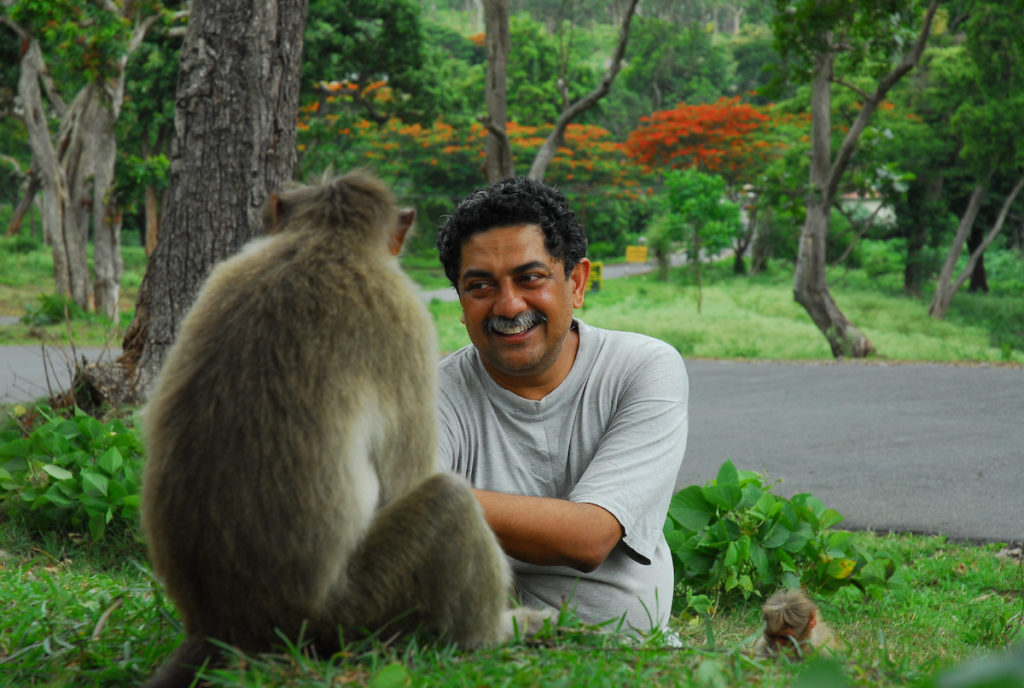
Anindya “Rana” Sinha is currently Professor at the National Institute of Advanced Studies in Bengaluru, Senior Scientist at the Nature Conservation Foundation in Mysuru, Adjunct Faculty at the Centre for Neuroscience of the Indian Institute of Science in Bengaluru, all in India, and Honorary Research Fellow at the College of Humanities of the University of Exeter in Exeter, UK. He had earlier studied botany, with specialisation in cytogenetics, at the Calcutta University in Kolkata, India and earned a doctorate in molecular biology in 1993 from the Tata Institute of Fundamental Research in Mumbai, India, having worked on the biochemical genetics and molecular biology of carbohydrate metabolism in baker’s yeast.
Sinha’s early research concerned the behavioural biology of wasps, social cognition in macaques, classical genetics of human disease and the philosophy of human-nonhuman species relationships, which he studied at the Centre for Ecological Sciences of the Indian Institute of Science and the National Centre for Biological Sciences, both in Bangalore, India. His current research interests, which he has been involved in over more than the last two decades, have, however, primarily been in the areas of animal behavioural ecology, cognitive ethology, evolutionary biology, population and behavioural genetics, urban animal studies and conservation biology, particularly of primates and elephants but of other animal taxa as well. More specifically, Sinha’s academic contributions, in recent years, have primarily been in the understanding of cognitive mechanisms underlying complex 23 social behaviours—acquisition and self-referential use of social knowledge, tactical deception and referential gestural communication—in wild bonnet macaques; resource utilisation, niche partitioning and conservation biology of primate communities in the lowland rainforests of northeastern India; and the influence of individual histories, enclosure properties and visitor presence on abnormal stereotypic behaviour and reproductive performance of captive lion-tailed macaques across Indian zoos. Sinha was responsible for the discovery of a new macaque species, the Arunachal macaque, in 2005, in the Eastern Himalayas and has subsequently researched collaboratively on the evolutionary history and population genetics of this species across its distribution range in western and central Arunachal Pradesh state in northeastern India.
He also leads a research team that has been investigating the population structure and demographic history of a population of wild bonnet macaques, subject to strong anthropogenic influences, in the Bandipur and Mudumalai National Parks of southern India in the long term and documenting the life-history strategies of more than 1,500 individually identified animals in this population over 15 years now. More recently, Sinha has begun to explore the urbanisation of macaque populations and the influence of human perceptions, attitudes and behaviour on this process across urban, rural and forest landscapes of the country. Finally, Sinha is deeply interested in the philosophy of biology, particularly of genetics, ecology and conservation, biology education and the popularisation of science in the country. He has, thus, been instrumental in establishing a Master’s degree course in wildlife biology and conservation in Bengaluru, India, works closely with the International Biology Olympiad, and has lectured extensively in a variety of educational institutions, including junior and senior schools, colleges and universities, and in research institutes, both across and outside India.

These perspectives depend on several theoretical frameworks to investigate cognition in animals is in terms of mentalistic notions. One such framework for perceptual consciousness is that of the intentional stance, which assumes that each individual is an intentional system capable of mental states like beliefs, desires and emotions. Several levels of intentionality can then be discerned, ranging from the zero level, where behaviours are entirely non-mentalistic—either simple reflex actions or learned responses—to the third level, seen in humans, where individuals have beliefs about beliefs, whether of themselves or of others. Another important functional framework encompasses attribution, whereby an individual is capable of attributing thoughts, emotions and desires to another individual. To attribute such mental states to both oneself and to others, then, is to have what has been termed a theory of mind. Social animals, in particular, appear to be knowledgeable about one another’s behaviour to different extents. But do they know as much about each other’s beliefs and intentions? Are they adept at recognising the similarities and differences between their own and others’ states of mind? Behavioural decision-making processes need to be analysed carefully in order to ascertain whether true higher-order intentionality can indeed be invoked as underlying mechanisms governing such behavioural acts. An alternative, more functional, perspective of nonhuman cognition, which must be briefly mentioned here, is that of distributed cognition, which disregards the ability of an individual to have observationally invisible mental states and only recognises communicative interactions and the behavioural dynamics within the entire group as manifestation of the socio-cognitive complexity that individuals are capable of displaying. To return to mentalism, the principal advantage that an animal enjoys if it is able to recognise that other individuals have beliefs, which might be different from its own, is that it becomes capable of immensely more flexible and adaptive behaviour. It might then be able to manipulate another individual’s actions and beliefs in a great variety of social situations.

Furthermore, if it can recognise ignorance in others, it can selectively reveal and withhold information from them. More importantly, novel information can be transmitted across individuals by a variety of social learning processes, including social facilitation, emulation or imitation. These last observations raise the very important question of whether behavioural traditions or nonhuman culture, which we are increasingly documenting in a variety of social species, including monkeys, apes, dolphins and elephants, and which may be mediated by social learning, have co-evolved with complex cognitive processes in higher mammalian social systems. Ontogenetic evidence to this end comes from a few examples, such as enculturated chimpanzees, which have better imitation abilities, suggesting that learning processes may be nurtured and shaped by the culture in which they are embedded.
More complex manifestations of an ability to attribute mental states and perspectives to others would also seem to require that individuals be reflectively conscious, and possess some degree of self-awareness. For individuals to clearly distinguish between their own thoughts and beliefs and those of others, for example, would obviously require some accessibility to their own minds. Current evidence for self-awareness in animals, however, seems to be patchy and inconsistent. Self-recognition refers to the ability of an animal to distinguish oneself from others without implying any awareness in doing so. Self-consciousness, in contrast, is a kind of meta-self-awareness, which implies that an individual is aware of its own state of mind, and can use this awareness to predict and explain the behaviour of both oneself and of others. This distinction becomes important because few mental processes ever become accessible to consciousness. Hence, it is possible to conceive, as seems to be evident in phenomena such as blindsight, that an animal could recognise its own position in a social group, distinguish between its own motives and those of others, and even attribute some beliefs to others without having reflective access to its own mind. Higher-order intentionality can be effective, however, only in the presence of some degree of truly reflective consciousness. To successfully deceive an audience, for example, an individual must be able to attribute false beliefs to others, and this can be achieved only if an animal is capable of comparing its own knowledge with that of other individuals. Such a task clearly demands at least some level of selfconsciousness, including an ability to be introspective. We hope to explore, these theoretical and philosophical issues in animal cognitive psychology, ranging from mental representation to distributed cognition, from simple, possibly learnt, behavioural responses to more complex, self-based, decision-making mechanisms, ultimately leading to the current status of our understanding of higher cognitive processes and consciousness in nonhuman species vis-à-vis human beings.
Publications
Sinha 1995 – Whose Life Is It Anyway – A Review of Some Ideas on the Issue of Animal Rights
Sinha 1997 – Complex Tool Manufacture by a Wild Bonnet Macaque, Macaca radiata
Sinha 2002 – Reflective Consciousness and the Emergence of Memes – Serial Evolutionary Pathways
Sinha 2003 – A Beautiful Mind – Attribution and Intentionality in Wild Bonnet Macaques
Sinha 1999 – Putting the Mind Back Into Nature – The Origin and Evolution of Consciousness
Sinha 2003 – Cognitive Ethology – A Behavioural Lens into the Primate Mind
Sinha 2004 – Social Knowledge in Wild Bonnet Macaques, Macaca radiata
Sinha 2004 – Tactical Deception in Wild Bonnet Macaques, Macaca radiata
Sinha 2004 – Tool Manufacture by a Wild Bonnet Macaque, Macaca radiata
Sinha 2014 – Experientially Acquired Knowledge of the Self in a Nonhuman Primate

